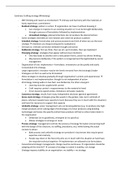Summary Crafting strategy (Mintzberg)
- NOT thinking and reason as involvement → intimacy and harmony with the materials at
hand, experience, commitment
- Realized strategy: pattern in action → organization can have it without knowing it
• Can emerge in response to an evolving situation or it can be brought deliberately,
through a process of formulation followed by implementation
• Unrealized strategy: planned intentions do not produce the desired actions
- Some strategies intended are not realized: plan need not produce a pattern
- Intended strategy: formal plans and pronouncements we think of when we use the term
strategy → intentions are cheap (compared to realizations)
- Get back to: intimate connection between thought and action
- Deliberate strategy: first we think, then we act; we formulate, then we implement
- Emerging strategy: strategies that appear without clear intentions
• One idea leads to another until a new pattern forms, action has driven thinking
• May become deliberate, if the pattern is recognized and the legitimated by senior
management
- Organization of one: implementor = formulator, innovations can be quickly and easily
incorporated into strategy
- Large organization: innovator may be ten levels removed from the (strategic) leader
- Strategies can form as well as be formulated
- Allow strategies to develop gradually (through organization’s actions and experiences) →
formulation is not implementation: thought is not independent of action
- All strategy making walks on two feet: one deliberate, the other emergent
• Learning must be coupled with control
• Craft requires control + responsiveness to the material at hand
• Errors become opportunities, limitations stimulate creativity
- Consensus strategy: results from many independent decisions (general agreement)
- Grass-roots strategy: strategies grow like weeds in the garden, take root in all kinds of
places, wherever people have capacity to learn (because they are in touch with the situation)
and have the resources to support that capacity
- Umbrella strategy: senior management sets out broad guidelines (e.g. to produce only high-
margin products at the cutting edge of technology or to favor products using bonding
technology) and leaves the specifics (what these products will be) to others lower down in
the organisation
• Deliberate (in its guidelines), emergent (in its specifics)
• Allows strategies to emerge en route
- Process strategy: management controls the process of strategy formation (concerning itself
with the design of the structure, its staffing, procedures, etc.) while leaving the actual
content to others
• Both process and umbrella strategy are prevalent in businesses that require great
expertise and creativity
• People way down in the hierarchy who are in touch with the situation at hand have
the requisite technical expertise → implementors are allowed to be formulators
- Conventional strategic management: change must be continuous → organization should be
adapting all the time BUT → concept of strategy is rooted in stability, not change
- Strategy imposes stability on an organization: no stability = no strategy
, • But how and when promote change? → focus efforts and gain operating efficiencies,
yet adapt and maintain currency with a changing external environment → clear
periods of stability and change
- Quantum theory of strategic change (quantum leaps): organizations adopt two distinctly
different modes of behaviour at different times
• Most of the time: pursue a given strategic orientation → stability, change (to
perfect) is in direction of orientation, organisations can exploit their strategy
• Gradually or suddenly strategic orientation moves out of sync with its environment
(world continues to change) → strategic revolution needed: alter many established
patterns → leap to a new stability
• During strategic revolution the organization can turn to its own emerging patterns to
find its new orientation (instead of having to develop new strategies or to import
generic strategies from competitors)
• Large, established, mass-production companies: rely on standardized procedures,
resist strategic reorganization → long periods of stability, broken by short disruptive
periods of revolutionary change
- Cycles of change: more balanced pattern of change and stability
• Creative organizations → sustain creativity by flying off in all directions from time to
time (BUT also need to settle down after such periods to find some order in the
resulting chaos)
• Adhocracy: organizations that produce individual, or custom-made, products (or
designs) in an innovative way, on a project basis
• Cycles of convergence and divergence
• Strategic failure: mixing change and stability or obsessing change/stability (at
expense of the other)
• The impulsive firm running blind (conventional business): identity crises can develop
(due to lack of change) without craftsmen or clientele knowing what to make of it
- Craft strategy: dedication, experience, involvement with the material, personal touch,
mastery of detail, a sense of harmony and integration
• Managers are involved, responsive to their materials, learning about their
organisations and industries through personal touch, sensitive to experience
- Managing strategy is mostly managing stability, not change → master the details
• Don’t reassess strategies continuously → program a strategy already created
• Strategic planning can be used to program a strategy NOT create one
- Much of the time, change is minor and even temporary and requires no strategic response
- Challenging to detect subtle discontinuities that may undermine a business in the future
• Unexpected, irregular
- Know the business! → personal knowledge, intimate understanding → facts are available to
anyone, but ‘wisdom’ not
- Manage patterns
• Recognize the emergence of specific strategies elsewhere in the organization and
intervene when appropriate
• Some patterns are worth watching until their effects have more clearly manifested
themselves → if useful, they can be made deliberate and be incorporated into the
formal strategy (even if that means shifting the strategic umbrella to cover them)
- Managers may have to live strategy in the future, but they must understand it through the
past end





